



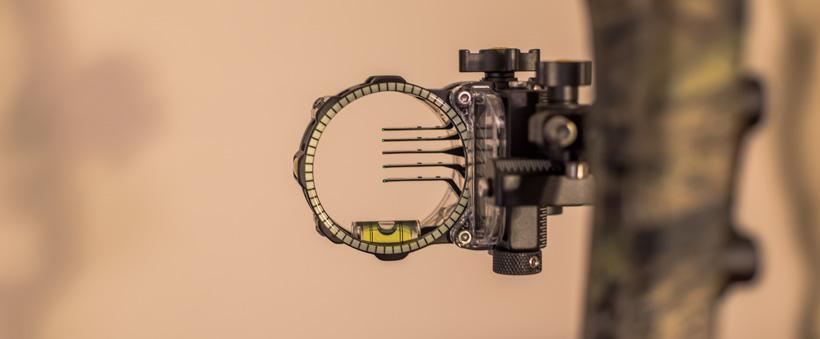
Multiple pin sight picture.
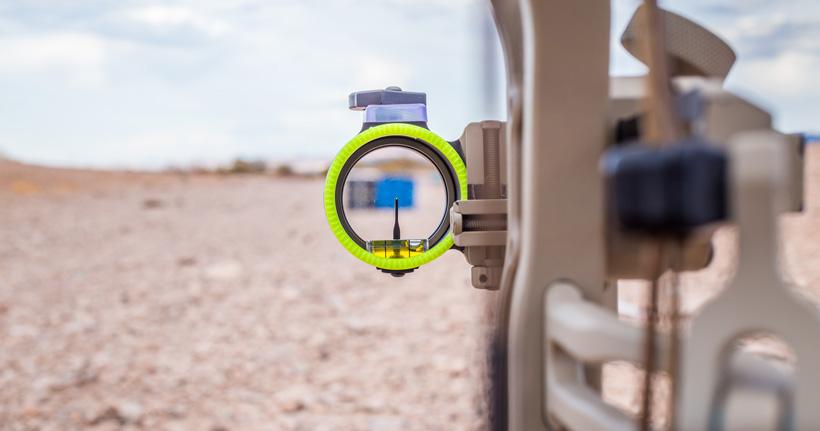
Single pin sight picture.
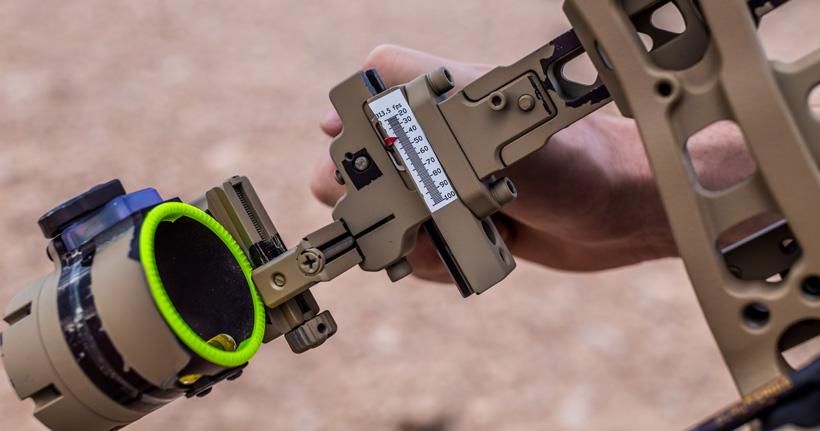



The joy of a slider sight is being able to stretch the distance in practice.
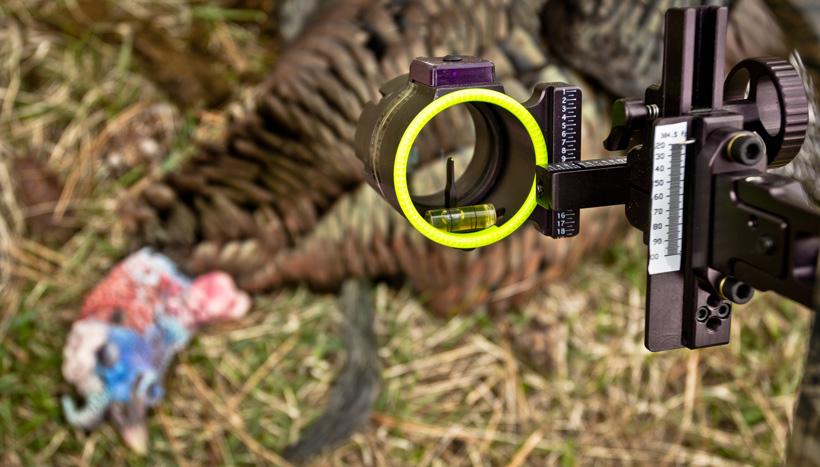
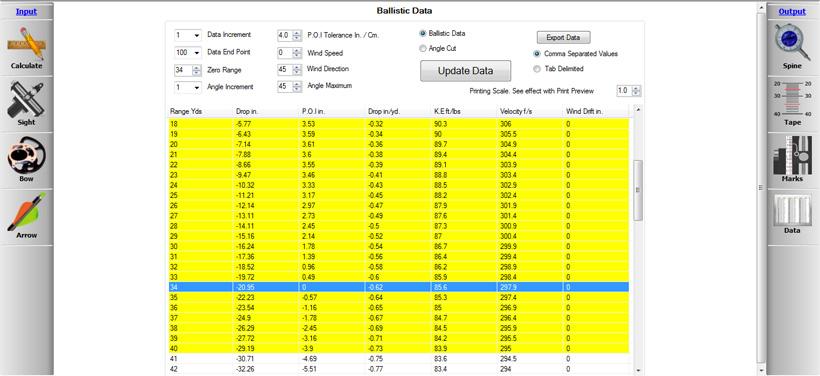

Photo credit: Dan Evans, Trophy Taker
Advantages | Clear sight picture |
|---|---|
Disadvantages | Quick yardage changes |
Advantages | Cannot use the wrong pin |
Disadvantages | More movement to adjust yardage |
Advantages | Precise aiming (dial pin to exact yardage) |
Disadvantages | Could take more time to get to full draw |
Advantages | Single object to focus on |
Disadvantages |
|
Advantages | Greater field of view |
Disadvantages |
|
Advantages | Faster target acquisition |
Disadvantages |
|
Advantages | No pin gaping |
Disadvantages |
|
Advantages | Adjustability |
Disadvantages |
|
Advantages | Disadvantages |
|---|---|
Clear sight picture | Quick yardage changes |
Cannot use the wrong pin | More movement to adjust yardage |
Precise aiming (dial pin to exact yardage) | Could take more time to get to full draw |
Single object to focus on |
|
Greater field of view |
|
Faster target acquisition |
|
No pin gaping |
|
Adjustability |
|
Advantages | Quickly adjust to different pin if animal moves |
|---|---|
Disadvantages | Clutter with so many pins |
Advantages | Low light situations |
Disadvantages | Confusion on what pin to use |
Advantages | Simplicity |
Disadvantages | Guess work on pin gap shooting |
Advantages | Less perceived movement |
Disadvantages |
|
Advantages | Disadvantages |
|---|---|
Quickly adjust to different pin if animal moves | Clutter with so many pins |
Low light situations | Confusion on what pin to use |
Simplicity | Guess work on pin gap shooting |
Less perceived movement |
|
There is no denying that bowhunters are extremely lucky with the equipment choices we have these days. With hunting season just around the corner, this is a great time to discuss single pin slider sights and multiple pin sights.
Obviously, there are a lot of advantages for each variation. The current market is dominated by fixed pin sights and the simple truth behind this market trend is more bowhunters are accustomed to hunting with this style of sight.
Regardless of the fixed pin sight popularity, I am a huge fan of single pin moveable sights. As someone constantly trying to find the perfect means to pump out accuracy and improve my chances for a clean kill each year, I am always on the lookout for a product that suits my needs — even if it means modifying a product so that it does. That said, I will do my best to explain why I prefer single pin moveable sights over fixed pin sights. Even long-standing fixed pins users may see the benefits of using a single pin slider type sight. If not, that is O.K. Just remember that you should always shoot what is the most comfortable to you.
Fixed-pin sights come in many different variations with configurations of pins in either a vertical line from the top or bottom or a horizontal line from the right or left side of the scope housing. There is one main thing that they all have in common: clutter! When you increase the number of pins, you actually create blind spots because the pins obstruct your view. A five to seven pin sight will obstruct at least 40 to 45% of your sight picture. This sight picture obstruction has the potential to increase the amount of time it takes for you to focus on the kill zone, which could lead to a missed shot opportunity. A single pin allows the bowhunter to keep their entire sight picture as clear as possible.
When you have four or seven or even nine pins in your scope housing, it can lead to confusion when you are trying to decide what pin to use. From a clarity standpoint, the best situation here would be a vertical stack of pins or a single pin. Difficulty can also arise during these situations when you are looking to find that fourth pin from the top or that red pin next to the orange pin. Even numbering your pins with tiny pieces of paper is confusing and only further adds to cluttering up your sight window.
While shooting at archery shops ranges, I eventually hear someone say, “Dang…I just used my 50 pin instead of my 40 pin,” as their arrow sails beyond the target. Another thing to consider with today’s bows reaching speeds upwards of 350 fps is that pin gaps are going to be extremely small. This means that your 20, 30 and 40 yard pins might be stacked next to each other making it tough to decipher which pin to use. This would also be further emphasized based on how close your sight housing is to your riser. The closer your sight housing is, the smaller the yardage gaps will be; the further your sight housing is from the riser, the larger the yardage gaps.
On a fixed pin sight, pins are normally set for 10 yard increments. How often have you had a deer stop or stalk close to one bedded down at 20, 30 or 40 yards for a shot? I cannot think of many shots that I have had while bowhunting that have been easy whole number yardages. It is for this reason that I normally practice at varying distances. I can easily adjust my moveable sight to any yardage and know what my setup does at each location. Choosing the right pin in the heat of the moment is one of the major disadvantages of the multi-pin bow sight when compared to a single-pin slider model.
For odd yardages that do not exactly fit on your pins, it is easy to say that you will just hold over or under your 40 to 50 yard stack of pins if a deer appears at 44 yards, but when you are facing this actual scenario, selecting the right pin and knowing which one to hold over or under when you are already shaking with adrenaline is incredibly difficult. When you are drawn into the moment, my guess is that you will forget to hold your 40 yard pin high enough and you will possibly shoot under the deer or select the wrong pin. I have experienced it myself when I used fixed pins while hunting.
You have crawled on your stomach for hours and are now 65 yards away from a buck that is bedded parallel to your location with no wind and the buck is facing away from you. You have been practicing out to 80 yards all summer and are fully confident with a 65 yard shot. Your pin gap at this distance is increasing. Can you effectively hold between the 60 and 70 yard pins and get the correct yardage for the shot? Also, it is important to remember that this pin gap will be magnified if you are shooting a slower bow.
I really dislike the idea of gapping pins for the mental aspect and difficulty of getting pins gapped correctly when you start increasing in yardage. This is a perfect situation where a moveable sight would have been valuable because the antelope was unaware of your presence and you had time to range and set your sight to the correct yardage.
The main argument against single pin slider sights are these sights are too slow for hunting and they will cost them a shot if they try to range an animal, move the sight and then come to full draw to execute a shot. It is a common misconception that you only have a few seconds to draw back and release an arrow. If you have time to range an animal, then you have time to adjust a sight to the correct yardage. With practice it becomes second nature to range and adjust your sight. Surprisingly, you can do all this with minimal movement.
Here's another example: you have a buck at 30 yards, you draw your bow back and he busts you. The deer spooks and runs out to 40 yards, stops and turns back to give you a another chance at a quartering away shot. With a multiple pin sight you can just raise your bow up to your 40 yard pin and release. With a single pin adjustable sight you would either have to guess on the 40 yard shot, let down and readjust your pin, which will most likely spook the deer, or develop a pin to use for close encounters and know the drop or rise of the arrow.
For those situations when you cannot move your sight on an approaching animal while using a single pin adjustable, you can set your sight ahead of time. This is mainly determined by your bow’s speed. This yardage mark is set to optimize your high and low marks for a set of distances. This is where having a computer software program will aid in what yardage mark to use. You want to find the optimum pin setting to use that will lead to being a few inches high at your low mark and a few inches low at your high mark. This will enable you to get a shot off if an animal comes in really fast (elk hunting) or if you are at full draw and an animal spooks and stops at a reasonable distance away.
Note: Do not just hold your pin at a given distance and expect to be low or high and still in the kill zone. The mentality that a speed bow can have one pin to 40 is clearly not true. There are too many possibilities for error to blindly hold a little high or a little low depending on the yardage. This optimum single pin setting is where a single pin acts like a fixed pin since you are holding over or under for in-between yardages. Take the time to practice at each distance even if you use a computer program to calculate your arrow drop to verify where you need to hold your pin to make a clean shot in a quick situation. Remember, if given the time, you can always move your pin.
The average kill zone of a mature deer is estimated at 10 inches. I cut that down to eight inches to ensure I am being as accurate as I can. Next, I personally believe that I can physically and mentally control a plus or minus hold over/under range of four inches in the heat of the moment. What I am referencing is the amount of hold over or hold under I would need to account for if I can't move my single pin.
My 2015 bow shoots 315 fps, and for me the optimum pin setting would be 34 yards. At this setting, it will be 1.71” high at 10 yards, 3.61” high at 20 yards, dead on at 34 yard and -3.90” low at 40 yards. Each setup is different and you can select what yardage to use based on what you are comfortable doing. After using an archery computer program, take your mark export and take it to a range and practice to visually inspect if the marks the archery software gave you are accurate.
In order to overcome close range and long range shots that happen too quickly for a change in pin setting, become intimately familiar with where your arrow impacts at varying distances prior to the hunt.
Since this can be a difficult task, you are going to want to practice taking shots with your single pin setting at various distances so you can avoid guessing your hold over or under for a single pin set at a close yardage. Practice using your pin at 40, 27.5, 10, 20, etc. Once you have figured out the optimum pin and know what it does at various distances, you can be prepared for those fast situations when you cannot move your pin. If you practice effectively, there is no guessing.
Another method would be to utilize a multiple pin sight housing on a slider sight and only use a few pins to avoid clutter. For instance, you could set your pins at 20, 30 and 40 yards and have your 40 yard pin be your slider. Doing this will have your sight tape ranging from 40 yards to your end distance. This is the perfect way to cover the short yardages for those quick scenarios when you cannot adjust the sight. The only problem with this method is forgetting to reset the sight back to the original setting in the heat of the moment.
Through personal experience, I have found that if you are about to take a longer shot, you will have time to range and move the pin, simply because you are not going to rush a longer shot. Also, the animal will most likely be relaxed and unaware of your presence.
If you want the best of both worlds, Trophy Taker recently came out with a Option hybrid sight that combines the reliability of a fixed pin sight and the precision accuracy of a moveable single pin sight into one. The sight can easily be switched from either mode by rotating the pin housing. This is a groundbreaking sight that provides bowhunters with both options. An impressive feature on this sight is the ability to run the slider pin and the multi-pins at the same time. The Option sight series is very well thought out and is a great sight for the technical minded bowhunter.
While a single pin moveable sight may seem like a difficult task, once you get used to it you will have a reliable setup that can cover any situation you are presented with. Whether it's treestand hunting, spot and stalk or calling in animals during the rut, once you learn how to operate a moveable sight, it will be difficult to go back to fixed pins. Again, I always feel like you have more time than you think when you're getting ready for a shot. After all, you're most likely rangefinding the animal before you draw, so that extra one second it takes to move your slider before you hook up your release isn't going to make or break the situation.
Fixed pin bow sights. These are usually a stack of pins ranging from 20 to 60 yards.
Single pin movable slider type. These allow the pin to be adjusted to the exact yardage and can either be set up as a single pin or multiple pins, with a “floater” pin variable that enables you to adjust for yardages past the bottom pin.